[REVIEW] Cloudberry Kingdom (Wii U)

System: Nintendo Wii U
Release Date: August 1st, 2013
Developer: Pwnee Studios
Publisher: Ubisoft
Author: Austin
It’s not often that a developer’s very first game manages to be both picked up by a big-name publisher and given some fairly significant attention prior to launching, but in the case of Pwnee Studios’ “Cloudberry Kingdom”, that indeed happened. Citing the plump plumber himself as inspiration, Cloudberry attempts to bring players along for a 2D platforming journey comparable to the best of them, and amid some lofty aspirations and interesting gameplay decisions, it’s clear that Pwnee Studios– although perhaps not masters just yet– knows how to put together a solid experience, and one worthy of your time.
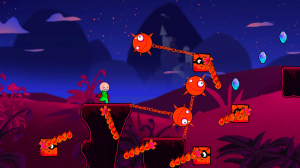
Curiously, when first booting up Cloudberry Kingdom, it would appear as though the game is very much inspired by something like Super Mario Bros. Spinning fire bars, enemies to jump on, and moving platforms are scattered about liberally, and any platforming fan would feel right at home with the simple game mechanics of running and jumping from left to right.
The similarities between Cloudberry and something like Mario are only skin-deep, however. Spend a few minutes with the game and you’ll realize that Pwnee aren’t attempting to achieve a long, satisfying adventure like we’ve seen from Nintendo side-scrollers, and neither is it going for the intricately crafted experiences in games like Mighty Switch Force!, or Mutant Mudds. Where those games try to deliver a composed, lengthy, and carefully paced experience, Cloudberry falls much more in line with a game like Geometry Wars or Tetris. The fun to be had here isn’t adventurous, nor is it deep– it’s a quick and easy burn that can provide absolutely ravishingly addicting play for quite a length of time if you let it.
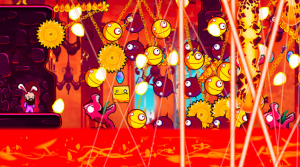
The backbone of this addiction is the ad-hoc level generator. All of the levels in any of the main modes of Cloudberry Kingdom are generated on the fly, which means each time you play through something like “Arcade” mode (to be explained later) you won’t see the same level twice. It’s a frightening prospect to be sure, and it’s easy to imagine how such a design tactic could backfire. What if it places a platform in an unfair place? What if it comes up with a level that is too easy? Or too hard? Or generally boring?
Thankfully, it appears as though Pwnee Studios managed to iron out all of those concerns quite decidedly. Never have I encountered a level in Cloudberry that was unbeatable, unfair, exceptionally easy, or exceptionally difficult. Upon occasion there may be a sudden, fairly minor difficulty spike or dip, but beyond that the levels feel tailored not only to the difficulty curve itself, but also to the type of character you’re playing as. It’s impressive, and well-suited to this manner of experience.
In addition that, the game allows you to generate levels by modifying a set of levers and bars that determine the frequency of enemy types, obstacle types, and the length of level itself. Pushing all of these bars to the top will result in something akin to what you see above, but don’t fret– even if there’s no way you can beat a level like that, the game lets you spend gems (the in-game “coins”) to watch a CPU complete it, to slow down time, or to map out a path for you to (attempt) to take. Small additions, but ones that are supremely enjoyable to play with just to see if you can overcome any of these insane, almost bullet-hell-esque platforming stages.
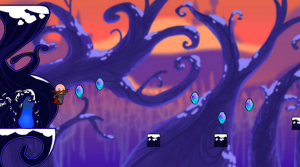
The reason why this game can succeed using randomly generated levels where something like Mario may fail by utilizing a similar tactic is simple: Cloudberry Kingdom is not an adventure-style 2D platformer, and it’s not trying to be. It’s offering players an exceptionally approachable platforming game with a strong focus on getting you to play just one more level. Levels are roughly 15 seconds long if completed without dying, and you’ll easily burn through 60-70 levels each time you sit down with the game. Such a high volume of completion is the reason randomly generated levels were almost a necessity.
This short-attention-span gameplay is supplemented by the zero-second pause between the completion of a level and the loading of the next one. Even if you wanted to stop, the level has already started by the time you thought about quitting, so you might as well try once more, right? All the while some suitable, repetitive electronic music thumps onwards in the background, causing an almost trance-like effect as you speed through level after level, dodging obstacle after obstacle, collecting gem after gem. It’s positively mesmerizing at times.
The best example of this is when myself and staff-writer Jack were playing the game’s cooperative mode (which supports up to four players), and told ourselves we’d start recording the next episode of our podcast when we got to level 52.
A while later, at level 75, we finally stopped only because our reserve of lives had run out.
Cloudberry Kingdom is that type of game, and it’s so, so good at it.
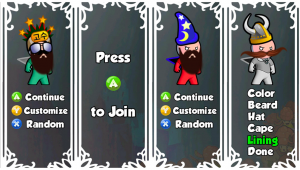
The core experience of Cloudberry is built upon the “Classic” character type, who can only run and jump. He doesn’t have a “sprint” button a la Mario, he doesn’t have a blaster pistol a la Maxwell from Mutant Mudds, he can’t double jump, he can’t pick up power-ups, and he can’t take more than one hit before exploding in a cloud of orange smoke. He is, by all counts, “Classic”.
But joining him are character types like the jetpack-wearing “Jetman”, the glued-to-a-pogo-stick “Bouncy”, and the extra-heavy “Fat Bob”. Among the 10+ suits to choose from, about half are worthwhile gameplay experiences. A few of them are merely mediocre but standable, but several are downright annoying. Characters like “Wheelie”– who is essentially a rolling wheel with lots of inertia– simply don’t lend themselves to platforming in concept, much less the briskly paced platforming of Cloudberry Kingdom. The “Bouncy” character (who rides one of those old-style bouncing horse toys) has the player constantly bouncing up and down while trying to traverse a level, which leaves an impression akin to the Spring suit in Super Mario Galaxy if you were forced to use that power-up 100% of the time. And if the platforming in Galaxy was way more intricate.
The level of precision required for many of the randomly-generated stages is simply too great for these types of suits to handle, and unfortunately they aren’t optional– “Story” mode forces the player to use the whole lot of suits at one time or another, and “Arcade” mode asks you to play extensively with each suit type in order to unlock some of the better ones. A minor gripe in the grand scheme of things, but a very clear-cut case of “too much content” in game design.
On top of that, the entire “Story” mode– although tied together by some chuckle-worthy cutscenes following washed-up platforming hero “Bob”– is more or less redundant. It’s essentially the same as “Arcade” mode (the game’s “endless” mode), but with more utilization of the frustrating suits, and levels that don’t appear to be randomly generated, but also don’t feel any more satisfying than ones that are. It’s not completely lacking in entertainment value, but put up against the game’s hypnotizing Arcade mode, it’s not particularly appealing either.
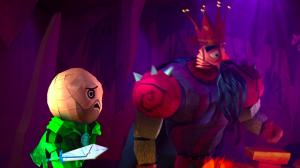
Hidden within the aforementioned “Arcade” mode is the metaphysical place in which the game was “meant” to be played. Within that menu selection are four sub-modes, called “Escalation”, “Time Crisis”, “Hero Rush”, and “Hybrid Rush”. The first two of these are really the meat of the game.
“Escalation” has players starting with a buildup of 15 lives, no timer, and a simple, short level catered to whatever “suit” you choose to play with. Upon completing the level, a slightly harder level will be presented to you. Upon completion of that level, a harder level still will be presented. Etcetera, etcetera, etcetera. The cycle continues Tetris-style until the levels become too hard for you to overcome and your lives run out, after which your score is firmly planted on the game’s local leaderboard. It’s easy to pick up, it’s fun to play, and it’s extremely addicting. (note: online leaderboards are on the way as well)
The only issue to be had with Escalation mode (aside from the fact that you have to play through it with the bad suits to unlock some of the good suits) is that the difficulty curve is exceptionally shallow. For a game that encourages quick and addicting play sessions, the first 30 or so levels of Escalation really aren’t very tough, and after you’ve played a few times they can feel more like a chore than anything. The game does give you the ability to start from intervals of 50 levels if you’ve made it that far before (50, 100, 150, etc), but doing this starts the difficulty curve too late, failing to allow the build-up of that ever-so-satisfying platforming momentum that comes from easier levels. Again, a minor problem, but one that exists nonetheless.
“Time Crisis” mode fixes that issue pretty concretely: You now have unlimited lives, but only 15 seconds on the clock. Gathering gems adds a few moments to your time, and if you complete a level with less than 2 seconds on the clock, you’ll be given a full 2 seconds to make it through the next level. This is where the game’s ridiculous, trance-like, almost-trippy vibe comes across fantastically, because– though the game is already so well tuned for constant motion– the timer truly forces you to jump right in and trust your muscle memory without giving the level a moment’s observation. This is also where the game’s level generator shines; this type of gameplay really couldn’t be done without randomly generating levels, and although some games have been done of similar concept in past, no one has managed to get random levels to feel like much more than a hodge-podge of messy nonsense until now. Pwnee Studios certainly deserves credit for that.

There isn’t too much to complain about with Cloudberry at the end of the day. Sure, sound effects and art assets look pretty generic (pulled out of the mid-2000s, as it were), and perhaps the long breaks of silence in between songs will take you out of the experience occasionally, but by and large it’s just a really solid game with a touch too much content that ends up making the whole thing feel a bit unfocused as a package. It could use some shedding of that fat, but ultimately the game’s ability to entrance your mind and steal minute after minute from your life isn’t diminished in any significant way.
Buy this game if…
… you enjoy addicting, arcade-y games like Geometry Wars or Tetris, or otherwise find 2D platforming to be fun.
Don’t but this game if…
… tough platforming isn’t for you, and you’re looking for a long-form experience with a sense of pacing and overarching satisfaction.
Want to reach Austin for some reason?
Try his twitter!
–
Want to participate in more NintendoEverything goodness?
Try our Facebook page!
Or our Twitter page!